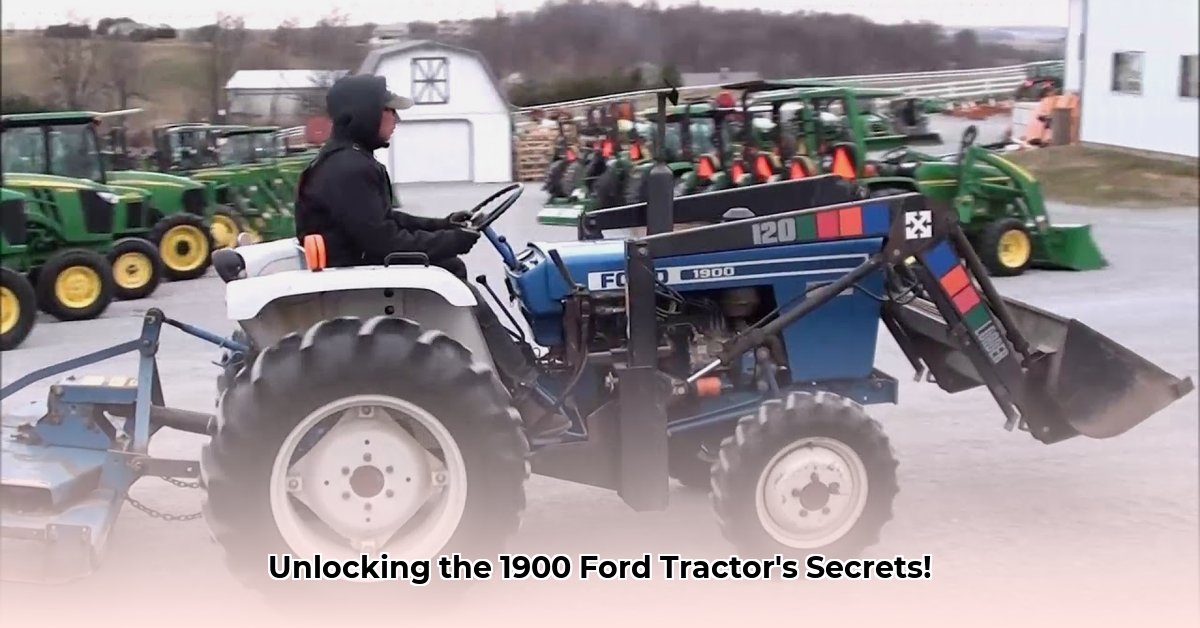
The Ford 1900, a compact powerhouse built by Shibaura for Ford from 1979 to 1983, holds a special place in the hearts of classic tractor enthusiasts. This detailed guide explores its specifications, performance, and legacy, providing valuable information for collectors, potential buyers, and current owners. Whether you're dreaming of a restoration project or simply curious about this iconic machine, let's delve into the details of the Ford 1900. For more on Ford tractors, check out this helpful resource: Ford Tractor Info.
Under the Hood: Engine and Performance
The Ford 1900's heart is a Shibaura LEM853, a three-cylinder diesel engine. This robust engine, with an approximate displacement of 1.4 liters, delivered approximately 30 gross horsepower – the engine's raw power output. However, the power transmitted to implements (PTO horsepower) was around 27 horsepower, sufficient for many common agricultural tasks such as mowing, tilling, and light hauling. While not a speed demon by today's standards, it provided reliable power for its time. Isn't it fascinating how much work this relatively small engine could accomplish?
Transmission and Drivetrain: Power to the Wheels
The 1900 featured a twelve-forward, four-reverse gear transmission, providing ample gear ratios to match speed and power to various tasks. This versatility allowed farmers to optimize performance, whether plowing a stubborn field or mowing a smooth lawn. The efficient drivetrain ensured that engine power was reliably transferred to the wheels for consistent performance. This design emphasized practicality and reliability, essential elements for farmers relying on their equipment.
Hydraulics and Implements: Versatility in Action
The tractor's open-center hydraulic system powered a range of implements, adding to its versatility. Farmers could attach a variety of implements, including mower decks, snowblowers, front-end loaders, and backhoes. The standard Type I rear hitch ensured compatibility with many common implements. This adaptability was a key selling point, allowing farmers to adapt their tractor to seasonal needs. How did this versatility impact the efficiency of farms using the 1900?
Braking and Steering: Control and Maneuverability
Stopping power was provided by a mechanical drum brake system. While functional, it lacked the power assistance of modern tractors. Some models offered optional power steering, significantly enhancing maneuverability, particularly in confined spaces. This difference highlights the evolution of tractor control systems. How did this impact the operator experience compared to modern tractors with power steering and assisted brakes?
1900 Ford Tractor Specifications: A Summary
The following table provides a concise overview of the Ford 1900's key specifications:
| Specification | Value | Notes |
|---|---|---|
| Manufacturer | Ford (Built by Shibaura) | Shibaura manufactured the tractor for Ford. |
| Engine | Shibaura LEM853 | A reliable three-cylinder diesel engine. |
| Engine Type | 3-Cylinder Diesel | Efficient and durable power source. |
| Engine Displacement | ~1.4 Liters | Compact yet powerful engine size. |
| Gross Horsepower | ~30 hp | Maximum power output of the engine. |
| PTO Horsepower | ~27 hp | Power delivered to attached implements. |
| Transmission | 12 Forward / 4 Reverse | A wide range of gear ratios for various tasks. |
| PTO Speed | 540 RPM | Standard speed for many agricultural implements. |
| Hydraulic System | Open-Center | Common hydraulic system for this era. |
| Braking System | Mechanical Drum | A dependable, but manual braking system. |
| Rear Hitch | Type I | Universal hitch for various implements. |
Strengths and Weaknesses: A Balanced Perspective
Like any machine, the Ford 1900 had both advantages and disadvantages. Its compact size and versatility made it ideal for smaller farms or those with limited space. Its relatively simple design potentially simplifies maintenance and repair compared to more complex modern tractors. However, its lower horsepower compared to modern equivalents and less sophisticated braking and hydraulic systems are notable limitations. Consider the trade-offs between simplicity and advanced technology – how did this impact the overall usefulness of the 1900?
Market Position and Legacy: A Lasting Impression
Around 1982, a new Ford 1900 likely cost approximately $8,356 – a considerable investment at the time. It targeted farmers seeking a dependable and affordable workhorse. While its capabilities are less impressive compared to modern machines, its continued popularity among collectors underscores its lasting impact. The Ford 1900 serves as a testament to agricultural technology of the late 1970s and early 1980s. Do you think its legacy is primarily tied to its functionality or its historical significance?
Sourcing Parts: Keeping Your Ford 1900 Running
Finding parts for a classic tractor like the Ford 1900 requires a strategic approach. Online forums and communities dedicated to classic tractor restoration are invaluable resources. Specialized suppliers also cater to this niche market. Thorough online research can uncover a surprising number of parts and resources. Restoring a Ford 1900 can be a rewarding experience. What challenges and rewards might someone anticipate when undertaking such a restoration?
Conclusion: A Timeless Workhorse
This comprehensive overview of the Ford 1900 tractor offers a detailed understanding of its design, capabilities, and historical significance. Its strengths and limitations illustrate the progress made in agricultural technology, while its enduring appeal to collectors underscores its lasting legacy. The Ford 1900 remains a testament to the innovative engineering and enduring practicality of its era.